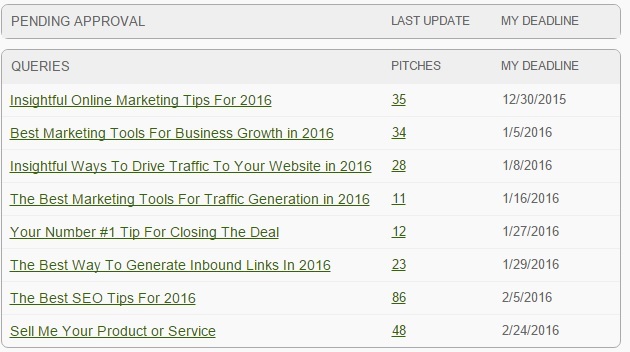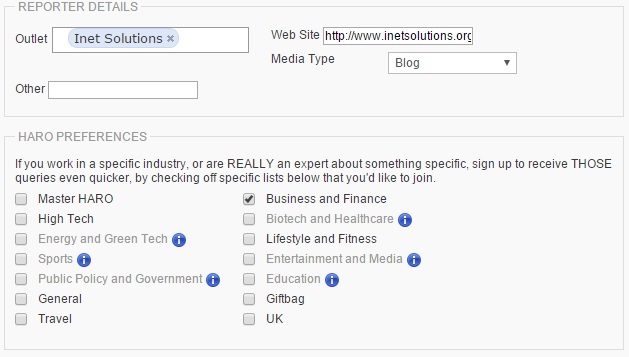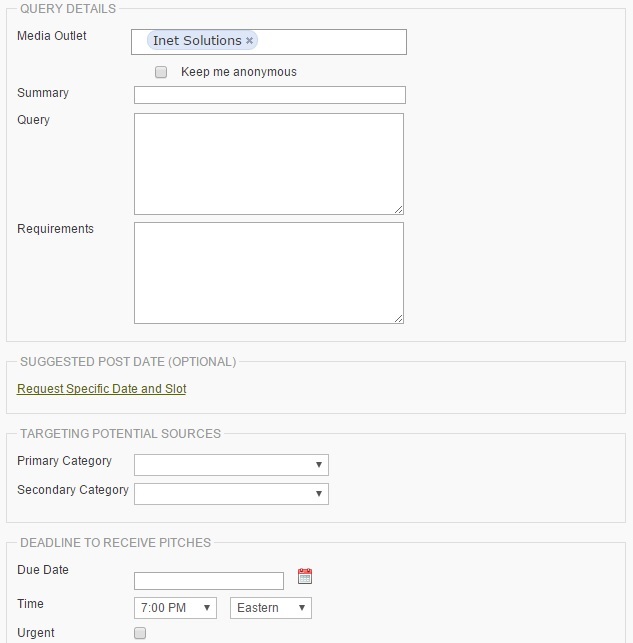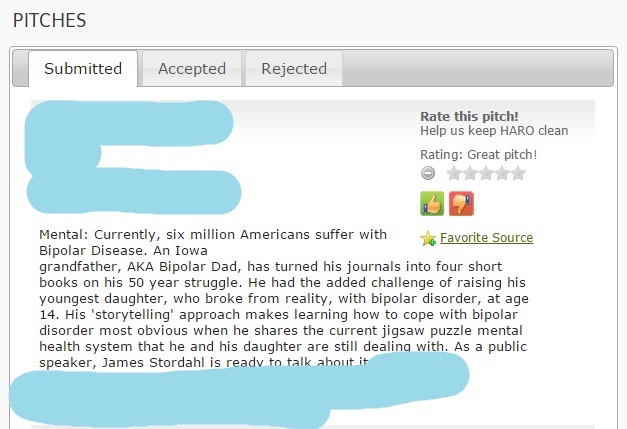How I Get Unlimited Content & Quality Backlinks For Free
The dream right? I mean, as a person involved in the SEO world, a land where you can get unlimited high quality human written content and then generate authority backlinks to that content (the big two), all for free, is the definition of the marketing Mecca, yes? Thought so. Well, this so called SEO Mecca is the destination of our journey today. Shall we?
What You’ll Learn
- The secret tool I use to get get unlimited high quality content and authority backlinks – yep, it’s just one, not a multitude of software.
- Step-by-step guide to getting the big two for free – I will show you how I created a mechanism, of sorts, to publishing amazing articles for my website and then subsequently generating quality backlinks to them including a ton of social media shares.
- Wrapping it up – everything in a nutshell…
The Secret Tool
I won’t keep you in the dark any longer. This secret tool is non other than Help a Reporter Out a.k.a. HARO. Basically, what HARO allows people to do is two-fold:
- Pitches – most HARO users use the tool to pitch reporters with their responses on certain subjects so that they can get a chance for their content (quote) to be included in that reporter’s article and thus get a link back to their site from an authority source.
- Queries – the other side of HARO is to use it as a reporter and send queries to pitchers/sources asking for their opinion on certain subjects and then including the answers you like in the article you are writing.
Now, you might think that it’s easy to pitch your amazing response and get featured in an article, and trust me, some extremely high quality media publishers are on HARO such as CBS and Investopedia, but in reality, there are a lot of people who pitch for these reporters’ queries, so it might take a while to get your pitch included in an article.
But that side of HARO is not something we will focus on in this tutorial. No. We will focus on the other one and that is acting as a reporter and getting high quality content by written by experts in your field and then, ultimately, getting them to link back to the article you put together from their quotes.
I think it’s pretty clear how amazing this approach is, but let me show you some results I have gotten from it, so that you guys know that it really works in terms of SEO and that it’s not just a strategy of filling your website with plain content:
Now, the image you see from above is from the HARO user panel and it basically shows your queries that were approved by the HARO team and sent out to HARO users (sources) who could then pitch their responses on the subjects.
I forgot to mention that HARO sends out a few emails per day to their sources which contain these queries by reporters and people who like a certain subject and feel like they are an expert in it can pitch in with their response and hope to be approved by the reporter who send the query.
As you can see, I sent out my first query on 30.12.2015, with an appropriate subject. Since then, I have sent another 7 queries all of which have turned into articles from the pitches that I have liked and approved. Now let me show you the organic traffic growth of the site since January 1, 2016 up until today:
Before I started using HARO, the site was getting about 70 – 100 sessions per day from organic search. Today, it has more than doubled and is now in the range of 160 – 200 sessions while still growing rapidly. Now, I know that this traffic would have grown anyways and it was still growing before I got on HARO, but thanks to this media publishing platform, it has skyrocketed.
It’s like every time I publish a new article created from the pitches of people on HARO, the organic traffic jumps by about 10% the next day and it stays there for the days to follow. I’m sure that if you follow our online marketing and SEO blog, you have seen the kind of articles I’m talking about – here’s one and here’s another one.
And on top of everything, as I already mentioned, all these articles get a lot of social shares as I reach out to the people who pitched in for them and they are more than happy to spread the word on their social networks.
Now, let me show you just how easy it is to use this approach – step-by-step.
Step-By-Step Tutorial To Using HARO
I don’t think that I said it, but the absolute best part about HARO is that it can be used for free. Yep, no charge at all. They do have some premium plans that will give you an extra edge over other pitchers/sources and increase your chances to get featured in those ridiculously high authority media outlets, but as I told you, in this tutorial, we will cover the being a reporter part of HARO. Let’s start at the beginning.
Step #1: Create An Awesome Website
Don’t expect your queries to be approved if you don’t represent an awesome and professional looking website that the content will be published on. HARO keeps things really high quality when it comes to reporters, so if your website looks like any of the examples you see here, you better ask your parents where they went wrong.
And when I say an awesome website, I mean from top to bottom – not just content or design, but everything. This will not only make sure that your media outlet gets approved on HARO, but will also get you way more pitches than you expected – after all, people want their website to be linked to from other great looking and professional websites right?
Step #2: Create Your HARO Account
As I already said, you can create a HARO account for free and it will allow you to do all the things you need to do in this tutorial. So just head over the their website and register. Once your accounts is validated and approved, login and go to the “My Account” tab where you need to tick the “Reporter” option if it is not ticked.
Straight from the registration, you can sign up as a reporter/journalist, but still make sure that the checkbox on the “My Account” page is ticked. Also, fill in all the details on that page, especially these:
The “Reporter Details” section is where you fill in the details of your media outlet and the “HARO Preferences” section is where you select into which category your media outlet goes to. Once you are done with these settings, just click “Save & Update” at the bottom of the page and go to the “My Queries” tab.
Step #3: Sending HARO Queries
This is probably the most tricky part. Once you have everything ready, you need to come up with a great subject that people will actually pitch in to respond to. Of course, depending on the topic your website is focused on, the number of pitches you get will strongly vary.
I have noticed that as I send more and more queries, people have more and more become familiar with my outlet (Inet Solutions) and more and more are pitching in to be featured in our articles. Now, it is extremely easy to create a query, but there are a few tricks I will aware you of:
This is the page where you create new HARO queries. The way you get there is from the “My Queries” page and then clicking on the “Submit Query” button on the right-hand side. Now let’s look at each of these inputs:
- Media Outlet – the website this article will be published on.
- Keep me anonymous – I never recommend ticking this as you will barely receive any pitches. Basically what this will do is not show where the content will be published and if you ask me, I wouldn’t pitch for that ever.
- Summary – the headline of your query. Make sure it is something unique and interesting that people would love to give their opinion on.
- Query – this is where you explain what you want each source/pitcher to do. In my case, I usually request 50 – 100 words of quotable content and then a name, company name, position at that company, and a link to the website.
- Requirements – this is where you fill in some specific requirements you might have for pitchers. I have never used this input.
- Request Specific Data and Slot – as I already mentioned, HARO sends out a few emails per day to their pitchers with the new queries that they have approved. With this option, you can request a specific date when you want your query to be included in HARO’s email.
- Primary and secondary categories – the category under which you want your query to be classified i.e. “Business and Finance”, “High Tech”, etc.
- Due Date – when this date passes, your query will no longer receive pitches. When you send out a HARO query, you will get most of the pitches in a few hours, but there are people who still might pitch after a day or two.
- Time – related to the above date.
- Urgent – I always tick this one, but I don’t really know what it does.
When you have filled in all the info, review it and then click the “Submit Query” button at the bottom of the form. Now, once your query is submitted, you will receive an email from HARO letting you know that they have received your query and will review it as soon as possible.
In that email, you will also find a paragraph letting you know that if it is urgent, HARO could share your query with their massive 110k Twitter following. Now this one is tricky as they will only share queries that have a same day deadline.
I generally try to take advantage of this any time I can as I get a lot of pitches in a short amount of time and I would recommend you do the same. And that’s basically it for your HARO query. Once it gets approved, you just need to wait until it closes for pitches and then it’s review time.
Step #4: Reviewing HARO Pitches
This part takes the longest, especially if you have a lot of pitches for a certain query. You pretty much have to go through all of them and then either accept or reject each individual pitch:
You get to review the pitches for a certain query by clicking on it from the “My Queries” page. By default, all pitches go into the “Submitted” tab, but to ease your process, you will have to accept the ones you like and reject the ones you don’t like.
You do that by reading each pitch and then clicking either the thumbs up or thumbs down icon on the right-hand side. I also occasionally give rating to great pitches, but never give low rating even to really bad pitches as I’m not particularly a fan of negativity.
Once you go through all pitches in the “Submitted” tab, and you have them filtered into the “Accepted” and “Rejected” tabs, you are ready to write your article.
Step #5: Writing The Article
The hard part is over. Now, all you have to do is use the high quality content provided by experts in your field to put together a great looking and valuable article – like this one or this one. Of course, depending on the pitches, you will either be quoting your sources or rewriting what they said.
I like the quote approach as it is simpler and also, it makes people really happy to see their words published by another person. Why not make other people happy when you can right?
Anyway, all you have to do right now is go through the pitches you accepted and insert that content into your article, of course, mentioning each and every person who contributed with a link back to their website.
Step #6: Spreading The Word
Once you are finished with your article and you publish it on your site, it’s time to get some rewards for your work. What I do is use Ditto Clipboard Manager to hot-wire a few clips (the email subject and email body) to hotkeys and I send an email to each and every person whose pitch was approved to let them know that their quote was included in my article.
Of course, I include a link to the article and at the end of the email, I politely ask if they can share it across their social media channels and if they can find it in them to link back to the article somewhere on their website. The results?
Usually the websites I feature add my article in their “Around The Web” or “As Seen On” pages, like this one or this one. So imagine if you include like 50 – 100 pitches in a post and then you reach out to all those people with the end article. If just 3 or 4 of them link back to it on their websites, what more could you ask for?
As you saw, the organic traffic stats are going through the roof since I started using this approach, so there is no doubt that it is working – very efficiently at that.
And that’s basically it guys. Simple, straightforward, and effective. As promised, high quality human written content plus authority backlinks and a ton of social shares as a result – all for free.
Wrapping It Up
So there you have it. A quick and effective way to improve on the two biggest factors in SEO nowadays – content and backlinks. I have to say honestly that HARO is simply an amazing tool and at first I simply couldn’t believe that there were no monthly subscription fees and what-not.
I mean, there are more than 475,000 sources and 35,000 journalists currently registered on HARO (it’s probably even more than that) and to think that you have access to all that for free is simply phenomenal. Opportunity?
















